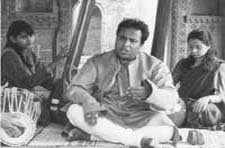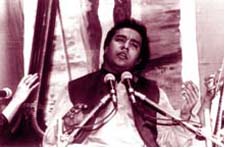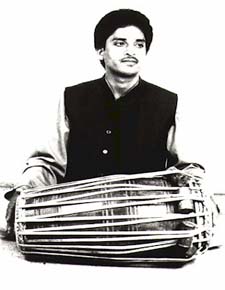UCLA Welcomes Ustad Faiyaz Wasifuddin Dagar's
Indian Classical Vocal Music Performance
By Nayla Huq
UCLA's Tom Bradley International Center
presented Ustad Faiyaz Wasifuddin Dagar's
awe-inspiring performance of the Indian
Classical Vocal Music style, Dhrupad, which
dates back to the Mughal Emperor Jalaluddin
Akbar's reign in the middle of the 16th century,
on Saturday, October 18.

Ustad Wasif is lost in his dhrupad raga
Courtesy of the UCLA Asia Institute |
The UCLA student association, SPIC MACAY, the
Society for the Promotion of Indian Classical
Music And Culture Among Youth, and NADA
organized this culturally enlightening event.
These groups are playing an essential role in
assuring the continuous fruition of Indian
classical music, and the work of the Dagar
family. Nearly extinct half a century ago, the
Dagar family took what was left of the dhrupad
style and brought it back to life.
Ustad F. W. Dagar is the twentieth generation of
dhrupad vocalists in his family. Previous
generations consisted of duos. His father and
uncle made up the 19th generation, and trained
Wasif. The innovative Wasif combines both his
uncle's and father's talents in his performance,
chanting a duet on his own in an already complex
musical composition. Singing two parts
simultaneously, his voice reaches beyond human
capabilities, achieving an unearthly level.
This godly vocal music floats all around the
lopping buzz and hum of two sitar-like
instruments called "tanpura," in the beginning
part of the performance, which is called the "alap."
The tanpura are played by Qamar Dagar and
Laurence Bastit. The alap is entirely melodic
improvisation free of lyrics that begins in the
middle octave, then gradually explores the
lowest notes of the lower octave.

The Ustad is entranced by the
spirituality of his music
Courtesy of newdelhi.net |
The second part, the "madhya laya alap,"
traverses the highest of the two-and-a-half
octaves used, which comes to a finish by sliding
back down to the middle octave, in which this
complex intricate vocalization, called "raga,"
began.
The alap is followed by another composition,
either the dhrupad or the "dhamar", depending on
the number and speed of the beats. This time,
the vocalization is that of poetic lyrics,
accompanied by the "pakhwaj," a single barrel
percussion drum played by Mohan Shyam Sharma.
"This composition rendition begins with a
straightforward recital of the fixed
composition, often traditional and ancient, and
usually consisting of two parts to four parts
from a poetic text." (Courtesy of SPIC MACAY's
Program of the performance)
The intimacy and enlightenment was not just felt
by the meditating yoga hippies. The Ustad,
meaning master and teacher, explained his music
and demonstrated the various beats as he sang,
gracefully and elegantly showing the music's
gestures.

A not-so-recent picture of Mohan Shyam
Sharma, the Ustad's trusted Pakhwaj
player.
Courtesy of surbahar.com |
Ustad Wasif explained that the raga was 90%
improvisation. The dhrupad, the raga accompanied
by the pakhwaj drum, initially follows a
distinctive rhythm in conjunction with the
vocalization, springing into a pronounced
departure from this collaboration, returning to
a new one in it's conclusion.
Dhrupad may be a very complex, esoteric type of
music, but the talent displayed by the quartet,
especially the Ustad and Sharma, are both
exhilarating and enlightening experiences that
move the soul.
I must admit however, that I was on the edge of
my seat during the alap, in anticipation of the
dhrupad, not that I really knew what any of
these were, but because the thundering drum is
the most exciting part of the raga, next to the
Ustad's single-voiced duet. Before this
presentation, I had only seen ragas accompanying
classical dances. My minds eye watched an
ornamented court dancer gesticulate and spin
about the room, executing the Ustad's
vocalizations.
His father's and uncle's concerts and music are
the subject of a 1992 French television
documentary, "Dagarvani." The Ustad has
performed in several European countries and in
prestigious American east coast venues.
Saturday's performance was his first visit to
California, and at the end of his performance,
the audience encouraged him to return with the
warmth of a family friend.
More information about this historically rooted
musical style and Ustad Faiyaz Wasifuddin Dagar
can be found at: dhrupad.org
October 24, 2003
http://www.asiaarts.ucla.edu/031024/ustad.html
|